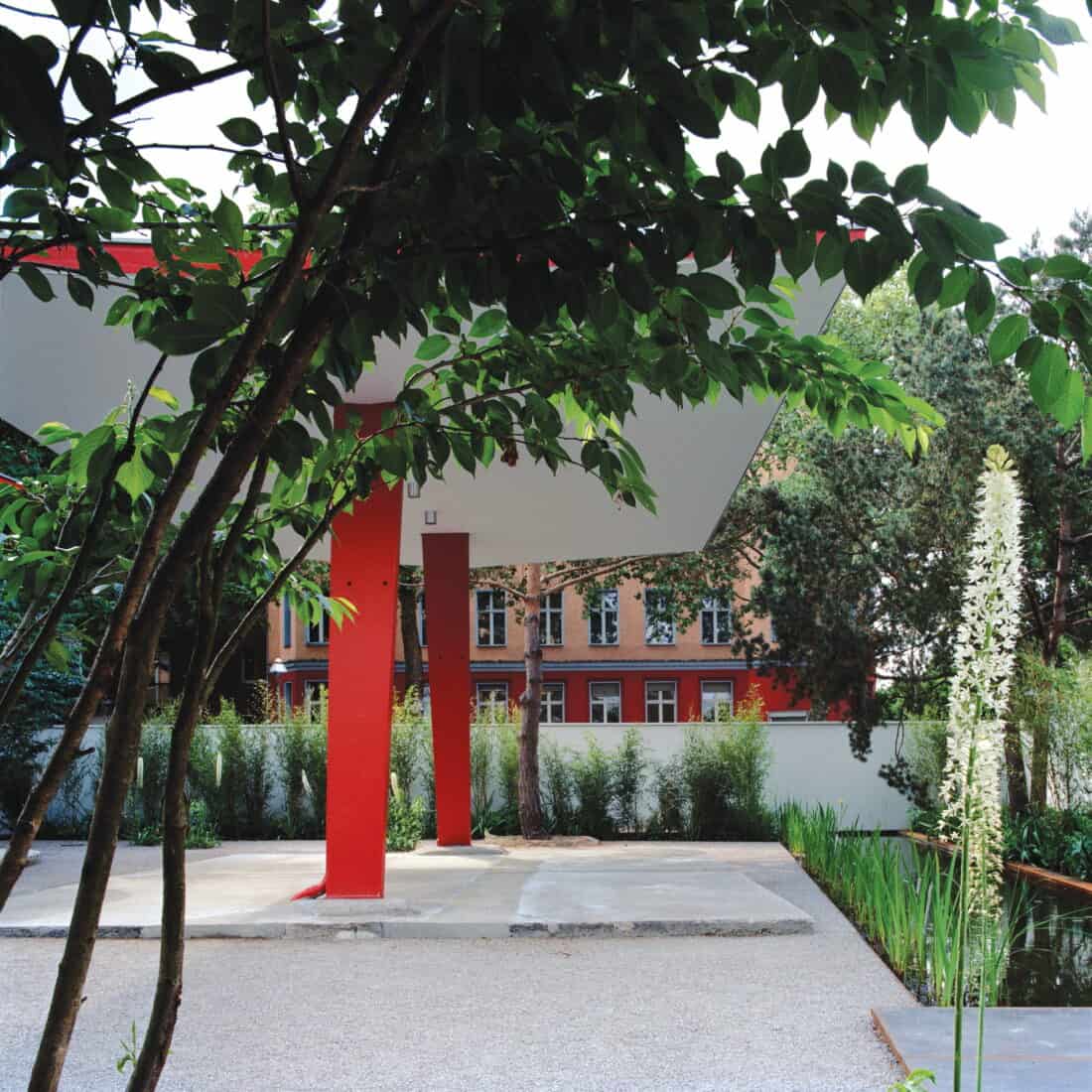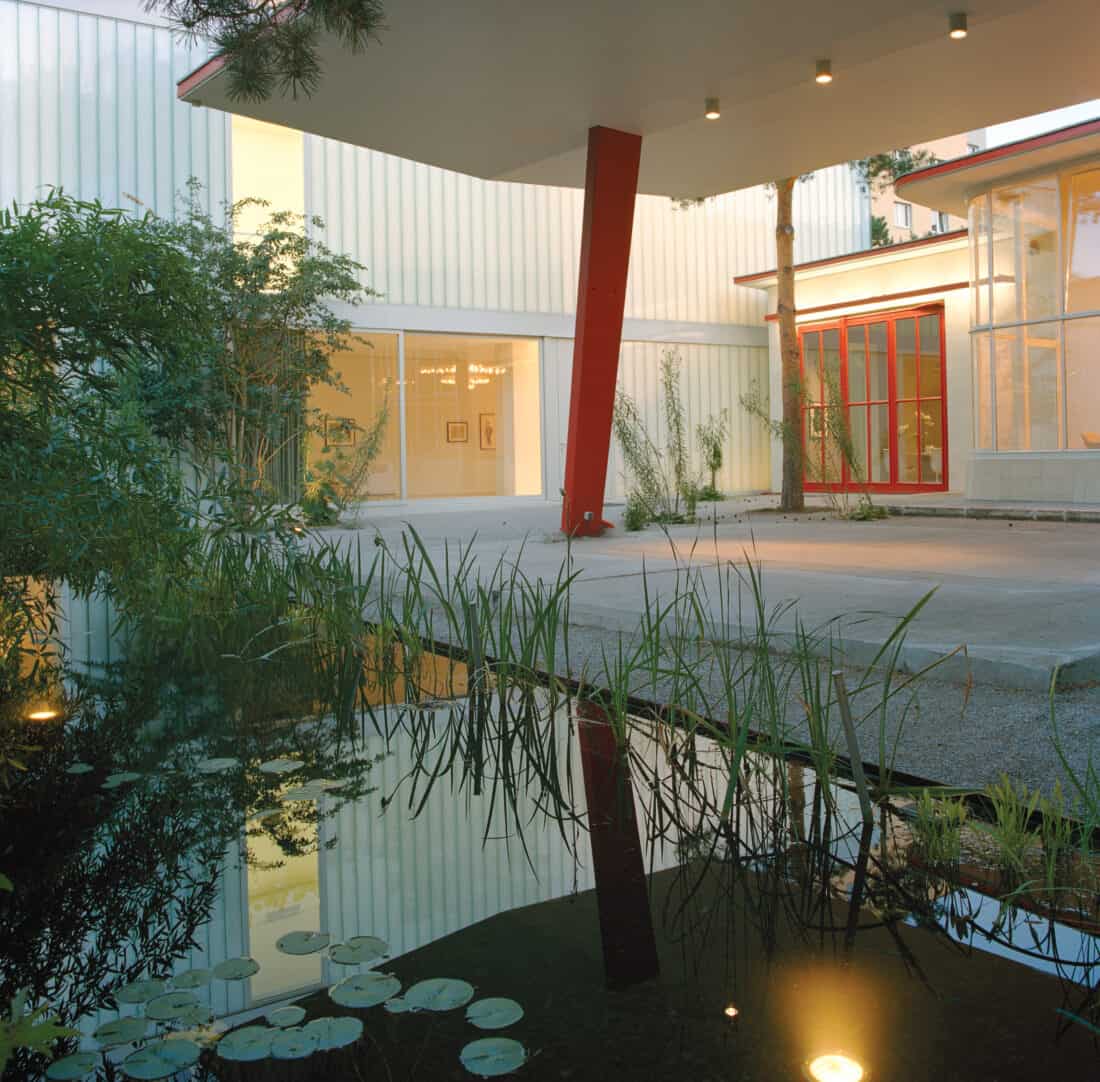As cities increasingly become places where cars are not welcome, the space that cars require will increasingly be filled with other things.
Bike lanes, bioswales, rainwater capture areas, gardens, walking paths, and other people-scaled elements and ecosystem service areas will fill the voids left by parking spaces and traffic lanes. But what will become of the ubiquitous gas station? The existing architecture of many of these properties lends itself to a recycled use that can become a clever and attractive public garden.

Garden Design inspiration from China’s Qing Dynasty
The property is an abandoned gas station dating back to the 1950s. It is in the heart of Berlin’s eclectic Schöneberg district – a densly populated urban area in Germany.
The client wanted a garden guided by the motto “Three Friends in Winter”. In East Asia these three friends are typically pine, bamboo, and plum. These three trees are known for their ability to survive the harsh winter conditions. They are also known for adding color to lifeless landscapes even when other plants and trees wither away.
The client had a vision for their garden, inspired by the ancient Chinese motto “Three Friends in Winter” (in Japanese culture they are also known as shō chiku bai).
In Asian tradition, these friends are represented by pine, bamboo, and plum trees. These three trees are known for their resilience in harsh winter climates. They also infuse barren landscapes with color, and they symbolize endurance and beauty amidst adversity.

This is what Hager Landschaftsarchitektur of Switzerland came up with:
“Inspiration came from an exhibition about the three great emperors of the Qing dynasty (1662- 1795). They counted garden design among their hobbies. The three “friends”, in this case, are the pine tree, with its sweeping crown carrying the snow, the bamboo, the evergreen symbol of eternal life, and the cherry tree, the first tree to blossom before winter is over.”
“The landscape architects were also inspired by a Fellini film and its mood – by the heat of summer, the scent of stone pines, and the chirping of crickets.”
The Design of the Gas Station Garden
A glass-walled studio building was added to the existing structure, with its shed roof typical of gas stations.
The gas station garden uses existing large pine trees were retained and clusters of cherry trees were added to grace the gravel terrain. Bamboo stands tall along the two-meter-high walls, offering privacy from curious onlookers.
Bee balm, campanula, yellow ragwort, foxgloves, and foxtail lilies grow alongside the bamboo. In addition to these species, columbines, willow leaf sunflowers, gauras, and phlomis also flourish in the gravel. Starting out as insular beds in the gravel, the plants are spreading naturally throughout the graveled area to naturalize the design over time.
As the garden evolves and naturalizes, columbines, willow leaf sunflowers, gauras, and phlomis plants spread across the gravel to create a vibrant meadow-like tapestry that surrounds an island of concrete. What was once the pumping stations is now the base of a covered patio.
A serene water basin adorned with water lilies and irises sits along the southern edge. It offers a reflection of the iconic architecture and a tranquil touch to the landscape.


I find this design to be entirely successful, and I love the creative reuse of the land. The irony is not lost on me; It was a gas station, no less! I like to think about how other abandoned industrial sites might be transformed into beautiful and creative homes and gardens.
It is kind of a spare design for me, but I like that the plants are intended to grow into the gravel. In time it will seem very natural, as long as unwanted weeds, which will surely seed into the gravel, are removed.
I’m always completely drawn to gardens that have gravel areas, and have tried creating the look for myself and clients, but I am always frustrated in the end with the level of weed control that is required. I agree, these types of pictures should always come with a warning — “massive weed control effort required”
Nice adaptive re-use. The stripped down approach works well with the mid-century modern station overhead.
I love it. I’d live or work there in a heartbeat. My masters thesis was about using phytoremediation to clean up old gas stations where the tanks had leaked– which is just about all of them. While this doesn’t seem to have anything to do with that, I love how keeping the canopy reminds people that this used to be a piece of the neighborhood’s infrastructure, and doesn’t just cover it up with something beautiful.
I’ve wanted to convert a gas station for SO LONG! Jealous.
Beautiful design. Nice article.